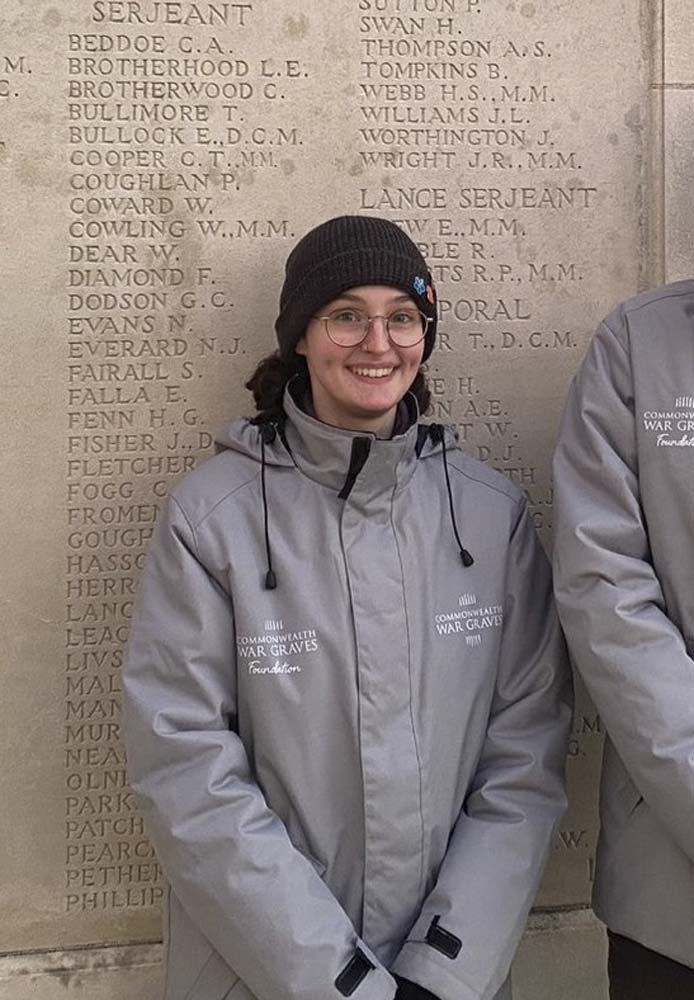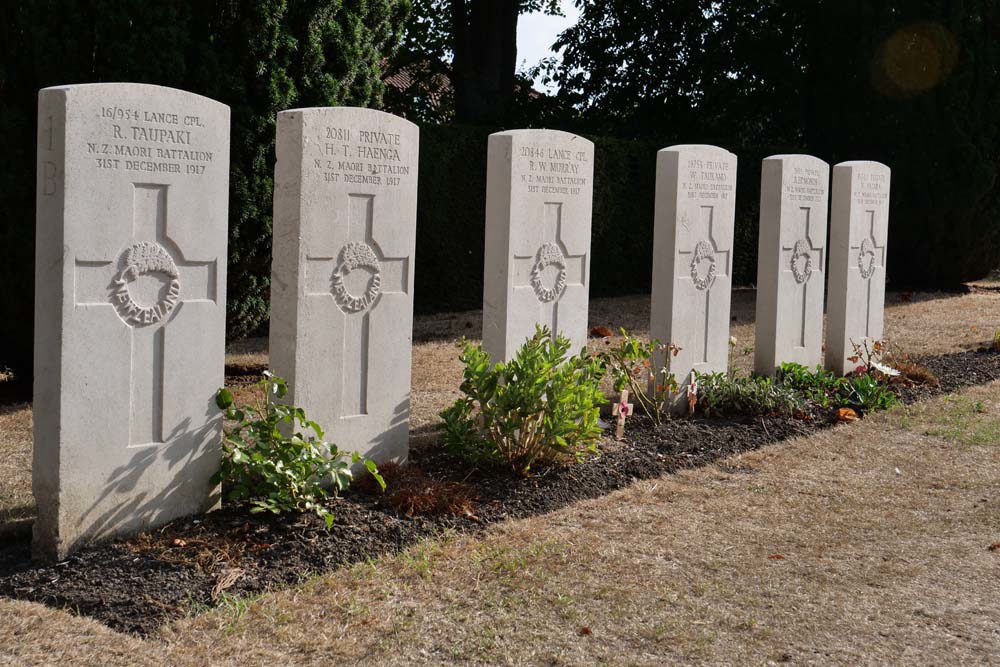06 December 2022
Why I became a Commonwealth War Graves Guide: Beth’s story
Fresh from her time in Belgium, Beth Crichton shares what she learned representing the Foundation and Commission as a Commonwealth War Graves Guide.
Commonwealth War Graves Guides’ experience

Beth, centre, and her Guides Programme Autumn 2022 colleagues.

About Beth
Being a guide has been a really unique opportunity and has allowed me to continue learning more about the Great War and especially the soldiers of the war.
I’ve enjoyed history as a subject since primary school and gained a specific interest in the First World War after visiting battlefields in Belgium and France when I was 16 with my secondary school. Alongside my interest in the war, I'm also interested in Native studies, especially the Indigenous peoples of Canada/Turtle Island.
An interest that I've been able to discover more about and learn of the roles of Indigenous peoples of the Commonwealth countries during the war.
Prior to my time in Belgium, I wasn’t aware of any contribution to the war effort by any Indigenous communities in the countries of the then Empire, I had never heard it spoken about when I was in school or in any other space where I had learned about First World War.
Beth’s Commonwealth War Graves Guide experience
During the training on our first week, we visited Ramparts Cemetery near the Lille Gate where I saw a headstone for a soldier of the New Zealand Māori (Pioneer) Battalion for the first time. I then really wanted to learn more about Māori soldiers during the First World War.
I found out about the initial reaction towards Māori men who wanted to enlist, as they were not European, the war was seen as not being theirs to fight. Despite any racially motivated exclusion at the beginning of New Zealand's involvement in the war, Māori soldiers were allowed to enlist. Though this was a contentious subject on both sides, as some Māori peoples did not support the idea of helping the British Empire that had displaced them from their native land and homes.
Even though the Native population had been mistreated for so many years prior to the outbreak of the war, many still felt a level of patriotism and chose to enlist. Eventually forming the New Zealand Māori (Pioneer) Battalion.
I was fortunate enough to find a soldier of the battalion in Tyne Cot Cemetery where I have been based during my time in Belgium.
Lance Corporal Jack Hunter was one of roughly 2,500 Māori and Pacific Islanders to serve in the Great War and one of over 300 who died. He is the only identified soldier of the New Zealand Māori (Pioneer) Battalion buried or commemorated in Tyne Cot.

Māori soldiers' war graves at Ramparts Cemetery, Belgium.
Although I could not find any specific information regarding his actions in the war or the events of his death, I was able to find the name of his parents and where in New Zealand/Aotearoa they were from under his additional information on the CWGC website. I also managed to find a picture of him online, which can be helpful to humanise them when you usually only see a name on a headstone or war memorial.
I have also had the great opportunity to visit various sites and museums in and around Ieper, including Memorial Museum Passchendaele in Zonnebeke (my personal favourite of the museums that I visited).
The section in the Museum about Canada included a board of information about a First Nations soldier who fought in the Canadian army: Frances Pegahmagabow.
Pegahmagabow enlisted in 1914, even though there were still strict rules regarding non-white, non-European soldiers’ involvement in the war.
During his service he earned the Military Medal with 2 bars, 1914-15 Star, British War Medal, and Victory Medal, making him the most decorated Canadian soldier of Native origin.
Frances Pegahmagabow survived the war and then turned to activism when he returned to Canada, fighting for equal rights for Indigenous peoples of the land.
The fight for Indigenous rights was a struggle many Native soldiers returned to after arriving home from the battlefields, despite their contributions and efforts during the war.
Guides programme allows Beth to grow and share her knowledge of Indigenous soldiers

Image: Commonwealth War Graves Guides view names on panels at the Arras Memorial
In addition to researching Māori soldiers and Indigenous soldiers from Canada, I learned some information about Aboriginal Australian soldiers.
There were a lot of restrictions at the beginning of the war preventing Aboriginal men from being able to enlist.
The laws surrounding enlistment did change later, however, the Australian government only allowed mixed-race Aboriginal men to fight “provided that the examining Medical Officers [were] satisfied that one of the parents [was] of European origin”.
Due to the rate at which Australia was losing troops, the Australian government had become quite desperate for more men to enlist.
Even in times of adversity their prejudiced views still seemed to outweigh the necessity for soldiers.
Despite this, Aboriginal men became soldiers in the Australian Imperial Force and fought alongside the white soldiers, with some being awarded medals for their efforts and courage.
Unfortunately, only now are their contributions starting to be recognised on an appropriate scale.
Among the many things I have been able to gain some knowledge about, I feel very privileged to have been given the opportunity where I could find out about the often overlooked or forgotten side of the war.
Although I was unaware of these soldiers' involvement in the war, I feel incredibly lucky to have learned some of the stories of these men as they deserve to be known and talked about just as much as the other soldiers.
This is something I feel very passionate about, and I found the Guide Programme gave me the opportunity to explore this.
Have you been Inspired by Beth and want to become a Commonwealth War Graves Guide? Apply now
We are looking for some exceptional individuals to join us as Guides (formerly Interns) in 2023.
We are currently recruiting from across the UK, Belgium, and France for this unique opportunity.
Discover more about the role below and follow this link to our Careers page for more information on how to apply.

